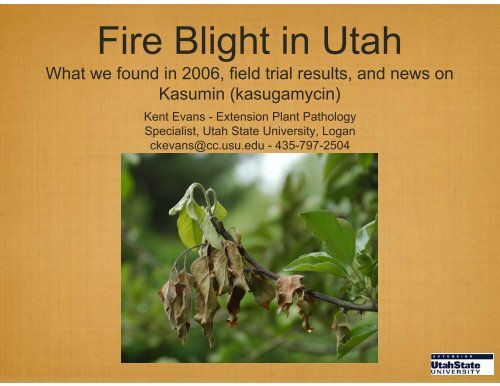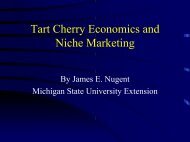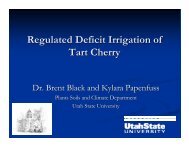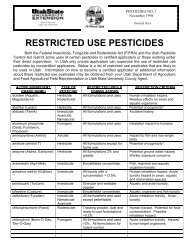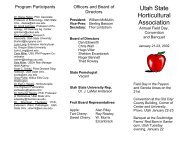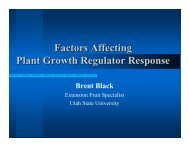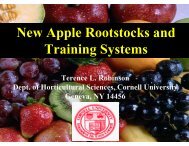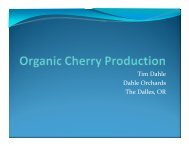Fire Blight in Utah - Utah State Horticultural Association Homepage
Fire Blight in Utah - Utah State Horticultural Association Homepage
Fire Blight in Utah - Utah State Horticultural Association Homepage
Create successful ePaper yourself
Turn your PDF publications into a flip-book with our unique Google optimized e-Paper software.
<strong>Fire</strong> <strong>Blight</strong> <strong>in</strong> <strong>Utah</strong><br />
What we found <strong>in</strong> 2006, field trial results, and news on<br />
Kasum<strong>in</strong> (kasugamyc<strong>in</strong>)<br />
Kent Evans - Extension Plant Pathology<br />
Specialist, <strong>Utah</strong> <strong>State</strong> University, Logan<br />
ckevans@cc.usu.edu - 435-797-2504
An outl<strong>in</strong>e of this presentation:<br />
A brief review of the biology of Erw<strong>in</strong>ia amylovora (Ea), the<br />
pathogen caus<strong>in</strong>g fire blight <strong>in</strong> apple and pear worldwide.<br />
A brief review of what we know about antibiotic resistance <strong>in</strong><br />
Ea populations, elsewhere and here <strong>in</strong> <strong>Utah</strong>.<br />
A presentation of the 2006 Kaysville shoot blight experiment.<br />
Survey results of Ea populations <strong>in</strong> <strong>Utah</strong> County and a few<br />
other places <strong>in</strong> <strong>Utah</strong> as reference.<br />
News about Kasugamyc<strong>in</strong> - Where do we go from here
Significance<br />
Erw<strong>in</strong>ia amylovora is a native pathogen of wild, rosaceous<br />
hosts <strong>in</strong> eastern North America.<br />
These hosts <strong>in</strong>clude hawthorn, serviceberry, and mounta<strong>in</strong><br />
ash. Other <strong>in</strong>troduced hosts <strong>in</strong>clude cottoneaster,<br />
pyracantha etc.<br />
Early European settlers <strong>in</strong>troduced apple and pear to North<br />
America.<br />
The first report of fire blight as a disease of apple and pear<br />
occurred <strong>in</strong> 1780, <strong>in</strong> the Hudson Valley of New York. In<br />
California, the disease was first reported <strong>in</strong> 1887.
Wash<strong>in</strong>gton Agricultural Exp. Stn.<br />
1915, Popular Bullet<strong>in</strong> No. 80.
Pathogen biology<br />
Ea is a member of the family<br />
Enterobacteriacae.<br />
Cells of Ea are gram-negative, rodshaped,<br />
measure 0.5-1.0 x 3.0 μm,<br />
and flagellated on all sides<br />
(peritrichous).<br />
Optimum temperature for growth is 27°C (81°F), with cell division<br />
occurr<strong>in</strong>g at temperatures rang<strong>in</strong>g from 5- 31°C (41-88°F).<br />
Identification of Ea isolates is based on biochemical and serological<br />
tests, diagnostic culture media, <strong>in</strong>oculation of immature pear fruits<br />
and apple seedl<strong>in</strong>gs, and DNA hybridization assays.
Disease Cycle
Symptomology
Control of <strong>Fire</strong> <strong>Blight</strong><br />
Streptomyc<strong>in</strong><br />
Oxytetracycl<strong>in</strong>e<br />
Copper<br />
Growth <strong>in</strong>hibitors (of apple)<br />
Biologicals<br />
Prun<strong>in</strong>g<br />
Burn<strong>in</strong>g
Agricultural Antibiotics<br />
Mode of Action: Inhibits prokaryote prote<strong>in</strong><br />
synthesis. B<strong>in</strong>ds to S12 prote<strong>in</strong> of 30S<br />
ribosomal subunit, prevent<strong>in</strong>g the transition<br />
from <strong>in</strong>itiation complex to cha<strong>in</strong>-elongat<strong>in</strong>g<br />
ribosome, caus<strong>in</strong>g miscod<strong>in</strong>g from DNA or<br />
<strong>in</strong>hibit<strong>in</strong>g <strong>in</strong>itiation of prote<strong>in</strong> synthesis.<br />
C 21 H 39 N 7 O 12 ·1.5H 2 O 4 S<br />
Streptomyc<strong>in</strong>-sulfate salt<br />
Streptomyces griseus<br />
Mode of Resistance: Mutation <strong>in</strong> rpsL (gene<br />
for S12 ribosomal prote<strong>in</strong>) prevents b<strong>in</strong>d<strong>in</strong>g<br />
of streptomyc<strong>in</strong> to ribosome. Am<strong>in</strong>oglycoside<br />
phosphotransferase also <strong>in</strong>activates.<br />
Streptomyc<strong>in</strong> resistant stra<strong>in</strong>s of Ea were first reported <strong>in</strong> California orchards <strong>in</strong> 1972.<br />
S<strong>in</strong>ce then, strep-resistance has been widely reported and was first detected <strong>in</strong> <strong>Utah</strong><br />
by Dr. S. V. Thomson circa 2000-2002().
Agricultural Antibiotics<br />
Mode of Action: Inhibits prokaryote prote<strong>in</strong><br />
synthesis. “Messes with tRNA” b<strong>in</strong>d<strong>in</strong>g to<br />
the ribosome thus affect<strong>in</strong>g cod<strong>in</strong>g of<br />
prote<strong>in</strong> syntheses.<br />
No observed resistance <strong>in</strong> populations<br />
of Ea <strong>in</strong> fruit orchards to date.<br />
C 22 H 24 N 2 O 9 ·2H 2 O<br />
Oxytetracycl<strong>in</strong>e dihydrate<br />
Streptomyces rimosus
Agricultural Antibiotics<br />
C 14 H 25 N 3 O 9 · HCl<br />
Kasugamyc<strong>in</strong> hydrochloride<br />
Streptomyces kasugaensis<br />
Mode of Action: prevents the <strong>in</strong>ocrporation<br />
of am<strong>in</strong>o acids by <strong>in</strong>hibit<strong>in</strong>g the b<strong>in</strong>d<strong>in</strong>g of<br />
the am<strong>in</strong>oacyl-tRNA-message complex and<br />
the ribosome.. prote<strong>in</strong> synthesis <strong>in</strong>hibitor.<br />
May cause phytotoxicity of apple and pear<br />
but some disagreement about this.<br />
Readily metabolized <strong>in</strong> bodies of mamallian species.
2006 Kaysville Shoot <strong>Blight</strong> Experiment<br />
Null hypotheses (assumptions that might be or<br />
might not be correct):<br />
• Antibiotics are no better than water <strong>in</strong>oculated treatment to<br />
prevent Ea shoot strikes.<br />
• Kasugamyc<strong>in</strong> is no better than any of the other agricultural<br />
antibiotics.<br />
• If data are not promis<strong>in</strong>g.....not a need for further test<strong>in</strong>g.<br />
• Kasugamyc<strong>in</strong> will cause phytoxicity.
2006 Kaysville Shoot <strong>Blight</strong> Experiment<br />
4 apple cultivars<br />
4 replications<br />
Inoculated 10 shoots/tree<br />
us<strong>in</strong>g a non-antibiotic resistant Ea<br />
Assessments ranged from 1-4<br />
1=no strike<br />
2> = strike<br />
Four spray treatments, and control, applied prior to <strong>in</strong>oculation:<br />
1. Water <strong>in</strong>oculated control (no antibiotic)<br />
2. Kasugamyc<strong>in</strong>-low (Arysta - 80 ppm)<br />
3. Kasugamyc<strong>in</strong>-high (Arysta - 100 ppm)<br />
4. Streptomyc<strong>in</strong> (Agri-Myc<strong>in</strong> - 100 ppm)<br />
5. Oxytetracycl<strong>in</strong>e (Mycoshield -100 ppm)
2006 Kaysville Shoot <strong>Blight</strong> Experiment
2006 Kaysville Shoot <strong>Blight</strong> Experiment
2006 Kaysville Shoot <strong>Blight</strong> Experiment
2006 Kaysville Shoot <strong>Blight</strong> Experiment
2006 Kaysville Shoot <strong>Blight</strong> Experiment<br />
Results:<br />
Dixie Red was most resistant cultivar.<br />
Ea <strong>in</strong>fection greatest on water-sprayed<br />
control.<br />
Oxytet was significantly better<br />
controll<strong>in</strong>g shoot strikes <strong>in</strong> Gala and Ida<br />
Red, was significantly better than water<br />
control <strong>in</strong> all cultivars, and overall trend<br />
shows it was better than other<br />
treatments on all cultivars tested.<br />
Kasugamyc<strong>in</strong> was significantly better than streptomyc<strong>in</strong> controll<strong>in</strong>g shoot strike on Ida Red;<br />
was significantly (@100 ppm) better than water <strong>in</strong>oculated control <strong>in</strong> all Ea-suscept cultivars;<br />
was equal to or better than strep (100 ppm for both) <strong>in</strong> all cultivars.<br />
Control of Ea-shoot strike <strong>in</strong> Gala and Ida Red, with streptomyc<strong>in</strong>, was no better than water<br />
(no control).
2006 Kaysville Shoot <strong>Blight</strong> Experiment<br />
Conclusions:<br />
1. No phytotoxicity was observed <strong>in</strong> any Kasugamyc<strong>in</strong>-treated apples.<br />
2. 2006 Kasugamyc<strong>in</strong> results demonstrate antibiotic efficacy aga<strong>in</strong>st Ea<br />
shoot blight.<br />
3. Kasugamyc<strong>in</strong> was, at times, better than streptomyc<strong>in</strong> controll<strong>in</strong>g shoot<br />
strikes.<br />
4. Bad news: shoot blight is extremely difficult to control effectively.<br />
5. Data <strong>in</strong>dicates need for further test<strong>in</strong>g <strong>in</strong> 2007.<br />
6. 2007 test<strong>in</strong>g to <strong>in</strong>clude blossom blight component and repeat shoot strike<br />
experiment.<br />
7. 2007 on-farm trial Arysta will provide some compound. Who wants to<br />
try it What will be measured as variables to <strong>in</strong>dicate efficacy
2006 - Surveyed population of Ea <strong>in</strong> <strong>Utah</strong> County and a few<br />
other places <strong>in</strong> <strong>Utah</strong> as reference<br />
• OBJECTIVES:<br />
• Evaluate a large number of Ea isolates for reaction to<br />
streptomyc<strong>in</strong>, oxytetracycl<strong>in</strong>e, and Kasugamyc<strong>in</strong><br />
• Determ<strong>in</strong>e the extent of resistance <strong>in</strong> any isolate of Ea found to<br />
be resistant to strep or other antibiotics (if any)<br />
• Evaluate Ea isolates reaction to Kasugamyc<strong>in</strong> <strong>in</strong> laboratory<br />
test<strong>in</strong>g
2006 - Surveyed population of Ea <strong>in</strong> <strong>Utah</strong> County and a<br />
few other places <strong>in</strong> <strong>Utah</strong> as reference.<br />
Over 300 Ea-suspect samples collected.<br />
Some samples were donated.<br />
<strong>Utah</strong> County, Box Elder County, Cache<br />
County were primarily sampled for Ea.<br />
Samples were processed <strong>in</strong> laboratory by<br />
cultur<strong>in</strong>g <strong>in</strong> nutrient broth.<br />
About 3000 serial dilutions were made.<br />
About 1500 cultures were plated on<br />
nutrient agar medium.<br />
Individual colonies of bacteria were<br />
selected and plated on to CCT.<br />
Ea colonies were selected, serial diluted,<br />
and subsequently re-<strong>in</strong>oculated on to<br />
CCT <strong>in</strong> order to <strong>in</strong>sure culture identity.<br />
Erw<strong>in</strong>ia amylovora positive<br />
NOT - Ea
2006 - Surveyed population of Ea <strong>in</strong> <strong>Utah</strong> County and a<br />
few other places <strong>in</strong> <strong>Utah</strong> as reference.<br />
Each Ea isolate was screened on 3 plates each of (this was<br />
done twice):<br />
1. Streptomyc<strong>in</strong> amended nutrient agar (30 and 100 ppm)<br />
2. Oxytetracyl<strong>in</strong>e amended nutrient agar (30 and 100 ppm)<br />
3. Kasugamyc<strong>in</strong> amended nutrient agar (30 and 100 ppm<br />
Isolates of Ea found to resistant to streptomyc<strong>in</strong> were<br />
retested on:<br />
200<br />
What do you th<strong>in</strong>k<br />
400 ppm streptomyc<strong>in</strong> amended nutrient agar<br />
1000}<br />
we found
2006 - Surveyed population of Ea <strong>in</strong> <strong>Utah</strong> County and a<br />
few other places <strong>in</strong> <strong>Utah</strong> as reference.<br />
• 122 Erw<strong>in</strong>ia amylovora isolates were made from <strong>in</strong>fected apple tissues <strong>in</strong> 2006 (40.6%<br />
of samples).<br />
• 32 Ea isolates were found to resistant to commercial rates of strep (100 ppm).<br />
• Resistant isolates were found at all commercial sites sampled (uniform distribution).<br />
32<br />
26%<br />
90<br />
74%
2006 - Surveyed population of Ea <strong>in</strong> <strong>Utah</strong> County and a<br />
few other places <strong>in</strong> <strong>Utah</strong> as reference.<br />
Of the 32 isolates resistant to streptomyc<strong>in</strong> at 100 ppm, 18 of those were resistant at 200 ppm<br />
and 14 were found to be resistant at 400 ppm (not immune as none were resistant at 1000 ppm).<br />
None of these isolates were observed to be resistant to Kasugamyc<strong>in</strong> at 100 ppm <strong>in</strong><br />
laboratory screens.<br />
14<br />
44%<br />
18<br />
56%
2006 - Surveyed population of Ea <strong>in</strong> <strong>Utah</strong> County and a<br />
few other places <strong>in</strong> <strong>Utah</strong> as reference.<br />
Conclusions:<br />
• High level of streptomyc<strong>in</strong> resistance exists <strong>in</strong> Erw<strong>in</strong>ia amylovora<br />
populations <strong>in</strong> commercial apples <strong>in</strong> <strong>Utah</strong>.<br />
• None of the isolates observed to be resistant to streptomyc<strong>in</strong> were<br />
found to be resistant to Kasugamyc<strong>in</strong> at 100 ppm <strong>in</strong> laboratory<br />
screen<strong>in</strong>g.<br />
• One isolate of Ea was found to be resistant to Kasugamyc<strong>in</strong> at 30<br />
ppm but the good news is that it was susceptible to streptomyc<strong>in</strong> at<br />
100 ppm. Resistance to one antibiotic does not automatically<br />
mean resistance to another antibiotic. Rotation of antibiotics is<br />
critical to ma<strong>in</strong>ta<strong>in</strong> efficacious control of Ea.<br />
• Evidence suggests a strong need to obta<strong>in</strong> Section-18 label<strong>in</strong>g for<br />
use of Kasugamyc<strong>in</strong> <strong>in</strong> commercial apples <strong>in</strong> <strong>Utah</strong>.
Thanks:<br />
Kirst<strong>in</strong> L<strong>in</strong>dstrom<br />
Tyler Olsen<br />
Joshua Pope<br />
Eric Rippl<strong>in</strong>ger<br />
Kaysville:<br />
Thor L<strong>in</strong>dstrom<br />
Er<strong>in</strong> Petrizzo<br />
Additional thanks:<br />
•Wayne McBride (IFA-commercial ag-antibiotic donation)<br />
•Layne Wade (Arysta Life Science - Kasum<strong>in</strong> donation)<br />
•<strong>Utah</strong> <strong>State</strong> <strong>Horticultural</strong> <strong>Association</strong> (fund<strong>in</strong>g assistance)<br />
•<strong>Utah</strong> Co. apple growers for sample donations<br />
•Dr. George Sund<strong>in</strong>, Michigan <strong>State</strong> University (strep-resistant Ea)
Special Thanks:


